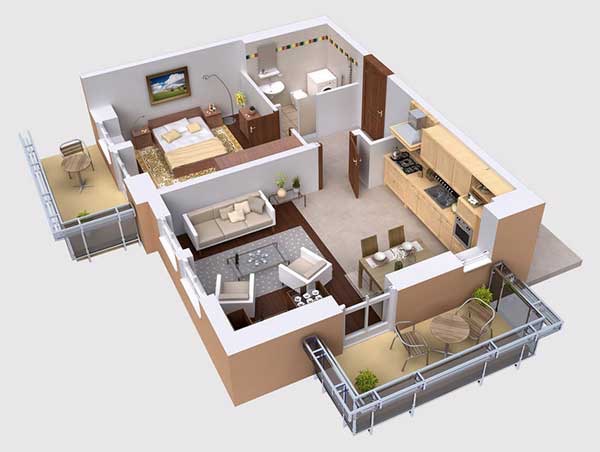Planning Building Renovations

Planning A Building Renovation
A step by step approach to renovating a building. We need to check what needs doing, calculate costs and make a budget. We need to consider the structural strength of the building, roof leaks, dampness in walls, electrical and water systems, kitchens and bathrooms and if we need to move walls and doorways to remodel the building.
For further information see:
- Renovating Tired and Scruffy Buildings
- A Strategic Approach to Renovation
- Remodelling Your House
- Mr Fixit Renovation Services
When renovating consider everything that needs doing and make a plan
Before you start it is wise to consider that the time of a major renovation is the time to look at all those things that need fixing before you start replacing floors or decorating. Typical things to consider are:
Make sure the structure is sound
Is the structure sound? If in doubt get a structural engineer to take a look. Make sure the building is stable before you start investing. Have you ever heard that sickening sound of a brand new $60,000 dollar built in kitchen exploding as a house moves or, even worse, the wail of despair from the person who paid for it?
Stop water penetration and dampness
Next look for water penetration or dampness in roofs or walls, these should be identified and corrected before you start doing any internal work. Pay particular attention to internal walls that are boundary walls and check these from the outside as well as the inside.
Upgrade, replace or repair water pipes and electrical wiring where needed
This is a time when you can solve problems with pipes and wiring buried in walls, ceilings or under floors. Do they need repairing or replacing? This might also be a time to rearrange things so that maintenance can be carried out. You might have noticed that quite a few bathrooms have an area of tile or marble that doesn’t match where the shower combination has had to be repaired in the past.
Old houses may often need rewiring, not a big or expensive job but maybe one well worth doing before you paint the walls.
Do you need more plug sockets? Modern houses need considerably more electrical outlets than houses built only a few years ago. Installing new plug sockets or light switches usually requires slots to be chiseled into walls to bring power down from the ceiling.
Lighting may need modification. Remember lighting is probably the most effective way of changing the ambience and atmosphere of any space. The lighting, and more importantly the wiring and switches, should be a forethought rather than an afterthought.
Kitchens and bathrooms need special attention
The parts of any house that tend to age most quickly or really let a house down are the kitchen and the bathroom. These will require special attention and may justify most investment. Changing floor or wall tiles may seem like a big job and certainly all the existing tiles most be removed with a hammer and chisel (very noisy and dusty for several days) but isn't as expensive as you might think. There are some excellent tiles available in Indonesia (they are exported all over the world) and it really makes a difference to the look of a place.

Building layout (remodelling)
Renovation also provides the opportunity to make layout changes that can improve your building. Open up a window where there is a view, add or close off a doorway. It may take a bit of imagination and you will need to make sure that changes can be carried out within the existing structure of the building.
Progressive renovation - make the worst into the best.
If you are doing only a partial renovation a good strategy to maximise your efforts is to identify the worst part of the house and invest in making it into the best part of the house.
The next time you do a partial renovation you repeat the process identifying which area is now the worst part of the house and, once again, turn it into the best.
Floors
Don’t skimp, if that floor is a sick colour change it, floors particularly make a huge difference. Don’t go for cheap white tiles.
When renovating it is well to remember that you get what you pay for.
Yes some contractors are expensive however if you negotiate too low a price you may well be harming yourself. The reality is that there is a “right” price for any job. If you negotiate below this you will probably find out the hard way that the contractor will only be able to complete the job to the low price by cheating in some way (although he will probably not consider it cheating ‐ he is simply satisfying your demand for a cheap job). He will not consider the concept of “substandard” you have already determined the standard by arguing the price
A simple but well carried out paint job makes a hudge difference
The thing that really makes the impact in any renovation is the painting. You start with a scruffy room and a brand new coat of paint is the largest single contributor to creating a clean fresh look. Unfortunately painting is one area where people very often skimp. There are some basic factors about painting that make a huge difference to the outcome.
A good paint job depends on several factors:
Surface preparation.
There is often more work in the surface preparation before you start painting than in the painting itself. Nails or irregularities must be removed. Paint only sticks as well as the weakest layer and it may be that three coats of paint ago the paint didn't stick very well. If there is a weak coat somewhere in the past the paint must be stripped back to this layer. Cracks must be filled and this may need a more technical approach than simply bunging a bit of filler into it.
Good edges
Good edges are critical for a good paint job so care must be taken in corners, around windows, doors and skirting boards. There may be difficulties if the walls are not smooth or square.
Quality paint
Low cost paint is very often false economy. High quality paint may cost more but it will be easier to apply and will cover well requiring fewer coats to get a good finish. It shpuld not be watered down or it will be too thin and the polymer film may well break down.
Good technique
Good technique is required to get a good finish. The paint should be worked to ensure good even coverage and when using a roller paint the edges first. When bringing 2 colours together in a corner paint across the corner with the first paint before painting up to the corner with the second. This makes sure the new paint is continuous through the corner.
I came across some people that had had their office building redecorated and were unhappy with the result. They had received 2 quotations for the work, the first was Rp35,000 per square meter and the second Rp25,000 per square meter. Naturally they went with the lower quote. They regretted it. No surface preparation was carried out, only 2 coats of paint were applied instead of 3 and the high quality paint specified was mixed half and half with very cheap low quality paint. They got what they paid for.
These days timber is getting more and more expensive so you may have to rethink wooden decks or solid teak doors. Once again be careful, in a recent high quality renovation that cost a lot of money those solid hardwood doors turned out to be Kamphor which is only a little stronger than a piece of toilet paper in the hands of a gorilla. The proud owners had a shock when, after only a couple of weeks, the door closing mechanisms were torn out of the woodwork. The contractor was a company that should have known better.
Things are improving, however, and these days there are good people available. Over the past 10 years the number of expensive, high quality buildings in Bali has increased dramatically. As a result the quality of workmanship in the industry has steadily improved particularly as a result of the building of international hotels where management understand quality and wish to invest what is needed to reflect 5 star facilities.
For further information see:
- Renovating Tired and Scruffy Buildings
- A Strategic Approach to Renovation
- Remodelling Your House
- Mr Fixit Renovation Services
Phil Wilson
Copyright © Phil Wilson
This article, or any part of it, cannot be copied or reproduced without permission from the copyright owner.
